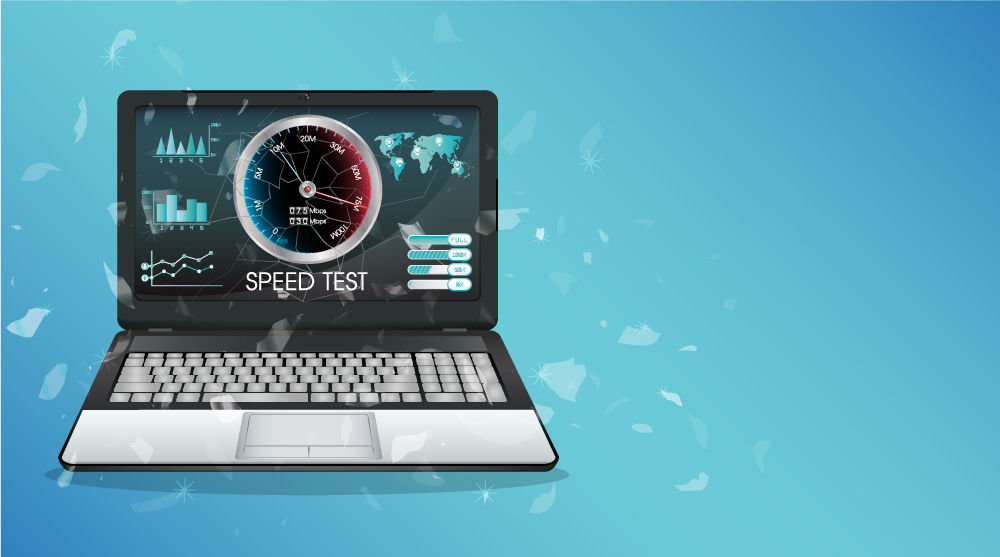What good is a fast computer if your internet speeds are less than ideal? Whether you use the internet to download, upload, stream, game, or browse, the internet has become a necessity for most computer users. But before you go and upgrade your internet to the fastest and most expensive package, let’s review some ways on how to increase internet speed on Windows 10.
Internet Speed
Internet speed refers to how much information and data can be transferred over the internet on a single connection at any given moment. Speed is so important because this will ultimately determine what activities you will be able to do online and how many devices you may have connected at once.
If you ever heard of upload speed vs. download speed and were confused by the meanings, don’t worry…most general computer users do not fully understand these terms. Download speeds refer to the rate that digital data is transferred from your internet to your actual PC and upload is the speed at which online information is being transferred from your PC to the web.
It’s important to remember that faster internet speeds don’t always mean that your computer will run at its fastest. That sounds confusing but let’s say that you have a semi-new laptop but an old router; even if you purchased the quickest and most expensive bandwidth, you might still be experiencing slow internet speeds. Many things have an impact on your internet speed, including your router, location, computer, etc.
Increasing Speeds on Windows 10
Knowing how to increase internet speeds on Windows 10 is not as difficult as one might think. So before you upgrade your package to the next tier of internet speeds, let’s go over some small ways that can help to increase speeds significantly. One of the first things you will want to do is test your current network speed, the type of connection you use and compare it to what package or speeds you are paying your provider for. If your internet provider does not offer a speed test, you can also check your speeds using various online tests.
- Closing Tabs & Apps that use Bandwidth
Some programs and applications may be using the internet in the background without you realizing it. Often, these apps can use up a significant amount of bandwidth, slowing down your upload and download speeds. Go to Start Menu and click on Settings> Network & Internet> Data Usage. The Data Usage screen will show you which apps are using internet bandwidth. If you notice an app that you rarely use, close the app. - Change Reserved Bandwidth
Windows 10 reserves a specific amount of bandwidth for Windows updates and then the rest is used for whatever we choose to use the bandwidth for, which may slow down speeds. Most of the time, users are not even aware of this, so changing the reserved bandwidth to zero leaves you with more available bandwidth and possible faster speeds.
Use Windows + R to launch Run window and then type gpedit.msc and press enter. Once the Local Group Policy Editor comes up, click on Administrative Templates > Network> QoS Packet Scheduler. On the right, double-click Limit Reservable Bandwidth, and a new window will appear. Select Enabled and then set Bandwidth Limit to zero. Click Apply and then Ok. - Disable Automatic Updates
If you have automatic updates turned on, this can consume a significant amount of data because it is constantly running in the background. Updates are important (especially network and driver updates), but if you can remember to manually update your programs or apps, then disabling this function may result in faster speeds. - Consider your router
If you have done all of the other tips and still find that your internet connection is not up to speed, then you may want to consider a router upgrade. Wifi relies heavily on routers which directly impact internet speed. A great place to start is to call your provider and see if they offer upgraded equipment (often they will replace older routers and cables if they upgraded their equipment since the time of installation). - Use a wired connection (ethernet cable)
If you are using a laptop or PC but connecting through wifi, consider using an ethernet cable to connect right into your main device. This can increase upload and download speeds if you are stationary at a desk. - Cleaning Temporary Files and Cache
Knowing how to increase internet speeds on Windows 10 may be as simple as clearing up some space. Temporary files like internet history, cookies, and caches take up a significant amount of space on your hard drive disk and may actually make your internet run slower. Try deleting them or clearing them to free up space and increase speeds. You can do this manually or with the help of a PC cleaning software program such as MyCleanPC.

